JAPAN PROVOKED, SEIZES MANCHURIA
Mukden, Manchuria · September 18, 1931
The political and economic consequences of the collapse of produce prices in the Twenties and the onset of the Great Depression in Japan were marked by an unemployment rate of 25 percent in 1931, factory idleness at 50 percent, exports down by two-thirds, malnourishment in farming settlements, and high tariff barriers in European colonial markets in East Asia. Using an argument similar to the Nazi’s mantra for Lebensraum in Eastern Europe, opportunistic Japanese politicians, military officers, and media outlets, with popular support (universal male suffrage was on the horizon), looked to mainland China for living space, new areas for agricultural exploitation, new markets, and a national economic recovery powered by an aggressive China policy. By 1928 many in Japan felt that Manchuria, a richly endowed province three times the area of the Japanese homeland and containing 40 million people, was the solution out of the economic distress felt by 80 million of their countrymen. On this date in 1931 Japan seized Manchuria by force after contriving an incident—the so-called Mukden Incident—when a 5‑foot section of railroad owned by Japan’s South Manchuria Railway was damaged in an explosion. Five months later, on February 18, 1932, Japan established the puppet state of Manchukuo (1932–1945), despite Chinese appeals to the League of Nations and to the United States under terms of the Kellogg-Briand Pact (1928) and the Nine-Power Treaty (1922). To create a semblance of legitimacy, the last Emperor of China, Pu‑Yi, was invited to be the head of state for Manchukuo. In actuality, Pu‑Yi was nothing more than a figurehead; real authority rested in the hands of Japanese military officials. Manchu ministers served as front men for their Japanese vice-ministers, who made all decisions. Most world powers refused to recognize Manchukuo, choosing to ignore Japan’s fait accompli and unwilling to engage the Japanese outside the halls of diplomacy. Japanese machinations in northeast China led to one expansive move after another and ultimately to full-scale war with China in 1937 followed by war with the United States and its colony-holding Allies in the Asia Pacific region. Within a year after Pearl Harbor, the Japanese aggressors had met their match.
[amazon_carousel widget_type=”ASINList” width=”600″ height=”200″ title=”Recommended Reading” market_place=”US” shuffle_products=”False” show_border=”False” asin=”1107020697,1846140102,0674012062,0742530914,0870137255,0812239121,0700616632,0691102228,0691145067,0520219341″ /]
Manchukuo: Springboard for Further Japanese Aggression in China and Southeast Asia
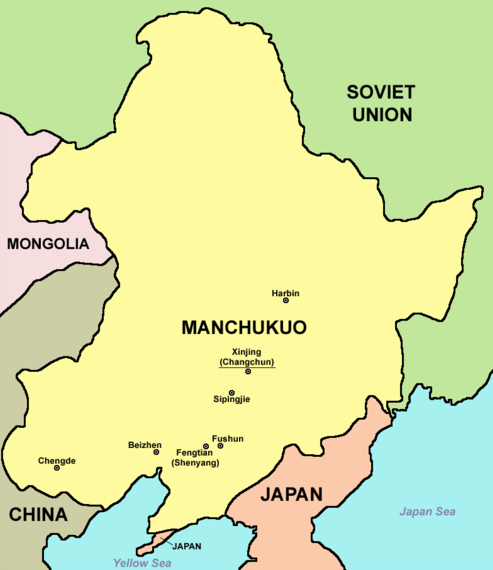
Above: Manchukuo (1931–1945) and its neighbors. Part of Liaodong peninsula and the Korean peninsula, labeled “Japan” on this map, had been Japanese possessions since 1905 and 1910, respectively. The Mukden Incident (September 18, 1931), which gave the Japanese the pretext to create the Manchukuo state, took place near present-day Shenyang, as it appears on the map. During the Manchukuo era Shenyang was called Fengtian in Chinese and Mukden in English and Manchu. Shenyang developed into a center of heavy industry during the Japanese occupation.
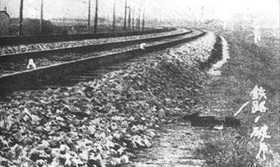 | 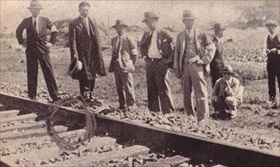 |
Left: Section of the supposedly damaged South Manchuria Railway tracks near the old walled city of Mukden (now Shenyang, capital and largest city of Liaoning Province, as well as the largest city in Northeast China). The Japanese caption on the right reads, “Railway Fragment.” The nighttime “sabotage” was planned by junior officers in the Japanese Kwantung (Guandong) Army, which was garrisoned in Manchuria to protect the Japanese-leased territories along the South Manchuria Railway and in the southern part of the Liaodong peninsula.
![]()
Right: A photo published in the jingoistic Japanese newspaper Rekishi Syashin shows several purported Japanese experts inspecting the scene of the Chinese “railway sabotage” on a very small portion (circled) of the main track of the South Manchurian Railway in September 1931. Most Westerners at the time believed the Mukden Incident, though coming on top of other Sino-Japanese incidents, was way overblown and should not have led to Japan’s takeover of Manchuria. Japanese publicists were quick to point out to their American audience how provocations in the Caribbean had brought swift intervention by U.S. Marines.
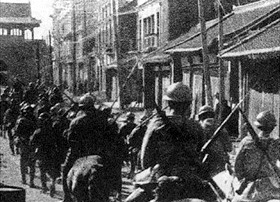 | 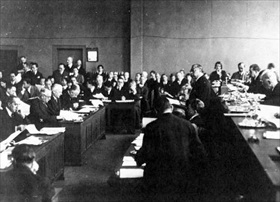 |
Left: Japanese cavalry entering Mukden (Shenyang), Manchuria, September 18, 1931, after claiming that the explosion on South Manchuria Railway tracks was a Chinese provocation. That same month Japan’s Kwantung Army began a military incursion in Northeast China (time to “cut the Chinese melon,” in the words of some army staff) and by December 1931 it occupied a large part of Manchuria.
![]()
Right: A Chinese delegate addresses the League of Nations after the 1931 Mukden Incident. The Chinese Foreign Ministry issued a strong protest to the Japanese government and called for an immediate halt to Japanese military operations in Manchuria. On September 19, 1931, China appealed to the League of Nations. A month later, on October 24, the League of Nations passed a resolution mandating the withdrawal of Japanese troops, to be completed by mid-November. Japan, however, rejected the League’s resolution. In March 1932, following February elections that gave the Japanese government a mandate to for its aggressive stance in China, Tokyo announced the establishment of the puppet state of Manchukuo. Japan also withdrew from the League of Nations in 1933.
Japanese Aggression in Manchuria and China, 1931–1945
![]()

 History buffs, there is good news! The Daily Chronicles of World War II is now available as an ebook for $4.99 on Amazon.com. Containing a year’s worth of dated entries from this website, the ebook brings the story of this tumultuous era to life in a compelling, authoritative, and succinct manner. Featuring inventive navigation aids, the ebook enables readers to instantly move forward or backward by month and date to different dated entries. Simple and elegant! Click
History buffs, there is good news! The Daily Chronicles of World War II is now available as an ebook for $4.99 on Amazon.com. Containing a year’s worth of dated entries from this website, the ebook brings the story of this tumultuous era to life in a compelling, authoritative, and succinct manner. Featuring inventive navigation aids, the ebook enables readers to instantly move forward or backward by month and date to different dated entries. Simple and elegant! Click 











